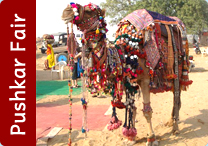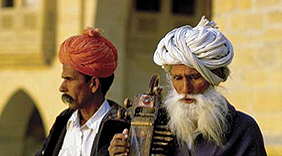
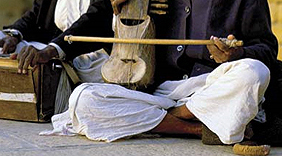

Custom Made Tour
Feel free to let us know if you are looking for customize tour program as all the tour itinerary is sample it can be modify according to your requirements.
Home - Rajasthan Travel Guide - Pushkar Tour
Pushkar Tour
History of Pushkar
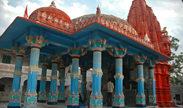
According to another legend, back in a legendary time, Lord Brahma was flying over the Rajasthan desert on his swan, when some petals fell from his hand and drifted down. Miraculously, blue lakes sprang up where the flowers had touched the soft sands. Just then, Lord Brahma realized that this was the auspicious moment to perform a fire sacrifice or yagna. His wife Savitri was not with him at that time and the yagna would be incomplete without her. So Brahma married a local girl and sat down for the without her.
Meanwhile Savitri landed on earth and upon finding this new bride sitting next to Brahma, she was raged with fury and cursed him that he would never be worshipped anywhere else on earth. Ever since then, when the full moon shines on Purnima during the autumn period of kartik, the desert tribes meet to commemorate this epic event. It is interesting to note that Brahma is not worshipped, even though he is one of the Holy Trinity of Hinduism.
 The holy dip in Pushkar lake on Kartika Purnima is thought to be salvation giving. Pushkar is very dear to Lord Brahma. The place is famous in His name. So it is blessed by Him in every way. In olden times the people who took a holy dip at Pushkar were relieved from all the sins and went to heaven after their death by the grace of Lord Brahma.
The holy dip in Pushkar lake on Kartika Purnima is thought to be salvation giving. Pushkar is very dear to Lord Brahma. The place is famous in His name. So it is blessed by Him in every way. In olden times the people who took a holy dip at Pushkar were relieved from all the sins and went to heaven after their death by the grace of Lord Brahma.Amongst the vastness and grandeur of India, discover a unique gem Pushkar. The town steeped in antiquity has tremendous potential that has been undiscovered until now. People taking dip in the holy lake
Due to its location and proximity to the existing "Golden Triangle", it is an ideal destination to project the charm of India as it is today. Well connected by train to Jaipur and Delhi, travelling to and from Pushkar is relatively inexpensive, fast and extremely safe.
Pushkar offers the complete and composite "Indian experience" as a historical, cultural, religious, rural and adventure destination that cannot be experienced anywhere else in a one- week tour of India.
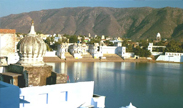
The city of Pushkar has over 400 temples in its confines. The only temple in the world of Brahma- the creator of the universe is here. Every major deity in the Hindu pantheon of gods is worshipped at Pushkar. Pushkar Lake is the holiest take in the country and a bath in the lake during the kartik full moon is said to cleanse one of all sins. The fifty -two bathing ghats along the banks of the lakes are linked to the lunar calendar, with each ghat having its own miraculous powers. It is one of the most holy pilgrimage sites in the country.
Throughout the year, Pushkar is the venue for innumerable fairs other then the Pushkar fair. Pushkar is transformed into a riot of colours and revelry as thousands of people throng the city to celebrate and rejoice. A glimpse of the festivities, the reflect the joy and love of life of the people in rural India.
Exquiste handicrafts and handlooms not only from Rajasthan but also from the rest of India is on display in the city reflecting the cosmopolitan nature of people who visit the city. Pushkar is considered amongst the better and least expensive shopping destinations in the country today.
 Pushkar offers the finest example of the diversity of terrain in India. It has hills, rocks, vegetation, lakes and above all the desert to provide the ideal venue for adventure activities of all kinds. The desert with its wide vistas and spectacular dawn and dusk located so close to the major cities provides a memorable experience in a tour of India.
Pushkar offers the finest example of the diversity of terrain in India. It has hills, rocks, vegetation, lakes and above all the desert to provide the ideal venue for adventure activities of all kinds. The desert with its wide vistas and spectacular dawn and dusk located so close to the major cities provides a memorable experience in a tour of India. The charm of Pushkar above all lies in its location. Nestled amidst the Arravali ranges, Pushkar radiates an aura of tranquility reflecting the peace and the open spaces of country life. The warmth and hospitality of the people will make a visit an occasion to remember.
How to Reach Pushkar
By Air : The nearest airport is at Jaipur 138-km from Pushkar. Pushkar is 375 km from Delhi.By Rail : The nearest railhead Ajmer is 11-km from Pushkar. There are trains to Delhi, Agra Ahmedabad (526km), Jaipur, Jodhpur and Udaipur. Two of the train services which connect Ajmer to Delhi and Jaipur are the Shatabdi Express and Pink City Express.

Pushkar General Information
Population : 30,000Area :5 sq. km.
Temperature :
Summer : Max 42 degree C Minimum 18 degree C
Winter : Max.23.3degree C Min.15.5 degree C Min.3.7degree C
Best Season : July to March
Language : English, Hindi, and Rajasthani.
PLACES OF INTEREST ARE:
Brahma Temple Pushkar boasts temples, though few are as ancient as you might expect at such an important pilgrimage site, since many were destroyed by Aurangzeb, a Mogul ruler and subsequently rebuilt. The most famous is the Brahma Temple, said to be the only temple in the world dedicated to this deity. The Brahma temple is an important pilgrim centre for the Hindus. It is nestled in the Pushkar valley which lies beyond Nagaparvat and the Anasagar Lake. This place, full of natural beauty, holds a special place in the hearts of Indian for it is believed that Lord Brahma, together with all the gods and goddesses, performed a Yagya here.The only standing temple in India dedicated to Lord Brahma, the creator of the universe, the structure around the temple was built in the 14th century and stands on a high platform near Pushkar lake. Brahma is one of the Holy Trinity in Hinduism, sharing the honour with Vishnu the Preserver and Shiva the Destroyer. Although a very large number of temples can be found all over India dedicated to Shiva and Vishnu, there are very few temples for Brahma, this being one of the holiest one.
 Marble steps lead up to the temple where a silver turtle lies embossed in the floor facing the sanctorum. The marble floor around the turtle is littered with hundreds of silver coins embedded in the floor, and so are the walls of the temple. Images of the peacock, the vehicle of Brahma’s consort Saraswati, adorn the temple walls. Brahma here is shown in a life-size form with four hands and four faces, facing four different directons. A hans (goose, the official carrier of Brahma) spans the gateway to the temple which is crowned with a red spire.
Marble steps lead up to the temple where a silver turtle lies embossed in the floor facing the sanctorum. The marble floor around the turtle is littered with hundreds of silver coins embedded in the floor, and so are the walls of the temple. Images of the peacock, the vehicle of Brahma’s consort Saraswati, adorn the temple walls. Brahma here is shown in a life-size form with four hands and four faces, facing four different directons. A hans (goose, the official carrier of Brahma) spans the gateway to the temple which is crowned with a red spire. A small statue of the milk goddess Gayatri (whom Brahma married) near Brahma’s idol is called Chaumurti. Steps within the silver-doored sanctuary lead down into a small cave which is a temple of Lord Shiva.
Pushkar Lake Pushkar Lake is an artificial lake, located near the town of Pushkar in Ajmer District. The lake was created in the 12th century when a dam was built across the headwaters of the Luni River. Legend has it that the lake was created when a lotus blossom dropped from the hand of God Brahma into the Pushkar valley. It was also the site where the Sage Vishwamitra meditating reputedly for thousands of years. Thousands of pilgrims come to bathe in the waters of the lake during the festival of Kaartika Poornima in November.
Circled by some five hundred odd temples, the lake has 52 ghats, which connect the temples to the water. These ghats were constructed by the rulers of the different erstwhile princely states of Rajasthan and some of them are aptly named after the states.

Every year on the day of auspicious Kartik Purnima, the full-moon phase of October/November, Pushkar Lake attracts thousands of pilgrims from all over the country to take a holy dip in its waters. It is believed that a dip at the lake on this auspicious day is equal to the penances done for one hundred years. The India profile offers tour packages for travel to Pushkar Lake.
Savitri Temple The temple is dedicated to Savitri, the wife of Lord Brahma and located on the top of the Ratnagiri Hill. According to the legends when Lord Brahma performed a Yagna (holy fire devoted to gods) along with Gayatri, a local milkmaid, furious Savitri cursed her husband that he would never be worshipped anywhere except in Pushkar and that too only once a year. Savitri left for the Ratnagiri Hill after cursing her husband and immolated herself there. There is beautiful statue of Goddess Savitri inside the temple.


